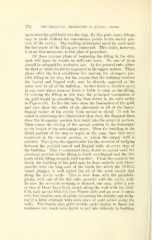Page 572 - My FlipBook
P. 572
272 THE TECHNICAL PBOCEDUBES IN FILLING TEETH.
up to meet the gold built into the step. By this plan, many fillings
may be made without the convenience points in the mesial por-
tion of the cavity. The holding insti'ument must be used until
the two parts of the filling are connected. This latter, however,
is in no wise necessary to this plan of procedure.
Of these various plans of beginning the filling in the step,
each will have its merits in different cases. No one of them
should be adopted for exclusive use. As the general rule, either
the first or third should be employed in the upper molars. These
plans offer the best conditions for making the strongest pos-
sible filling in the step, for the reason that the wedging between
the buccal and lingual walls may be directly opposed at the
same level in all of the building. In this there is decided merit
in any case where unusual force is liable to come on the filling.
In making the filling in this way, the principal lamination of
the gold would be something like that shown in the split cavity
in Figure 355. In this the lines show the lamination of the gold,
and also show the order of its placement in all of the bucco-
lingual center of the cavity from mesial to distal. It will be
noted in examining this illustration that, first, the diagonal lines
show the triangular portion first built into the gingival portion.
Then comes the raising of the mesial portion to the horizontal
at the height of the axio-pulpal angle. Then the building in the
distal portion of the step is begxm on the same lines that were
employed in the mesial portion, by which the pulpal wall is
covered. This gives the opportunity for the severest of wedging
between the parallel buccal and lingual walls at every step of
the building. This is continued from distal to mesial until the
proximal portion of the filling is fairly overlapped and the two
parts of the filling securely tied together. From this point to the
finish, the building of the gold may l)e done entirely with blows
parallel with the long axis of the tooth, for which the 10-10-3,
round plugger, is well suited for all of the work except that
along the cavity walls. This is best done with the parallelo-
grams, with one of the flat sides parallel with the cavity wall.
In case the severest wedging is desired, one may, after a row
or two of blows have been struck along the wall with the 12x6-
6-10, take up the 10x5-3-3 (see Figure 324) and go over it again
with this smaller area of point, increasing the density and wedg-
ing it a little stronger with each piece of gold added along the
walls. The fourth plan gives results quite similar to these, but
beginners are much more liable to get into difficulty in building


